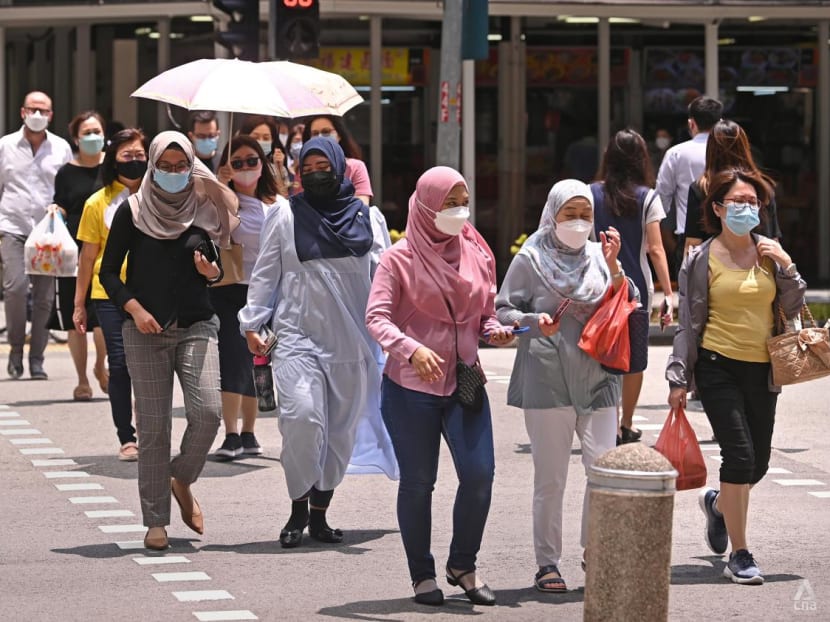Commentary: New COVID-19 variants have arrived. How worried should you be?
COVID-19 vaccines still do a good job keeping people safe from severe infections, hospitalisations and death – but that message may get lost in panic over variants, says Lisa Jarvis for Bloomberg Opinion.

People wearing protective face masks in the Central Business District in Singapore on Mar 25, 2022. (Photo: CNA/Gaya Chandramohan)
CHICAGO: Some rather alarming headlines recently circulated about the newest members of the Omicron family. “Nightmare COVID variant,” read one. “The most immune-evasive COVID variants yet.”
Or, as one would-be pandemic influencer said in a tweet shared thousands of times: “MOTHER OF GOD ... #COVID variants worse than CDC has been admitting.”
Apparently, it’s spooky season for COVID-19 variants.
Or not. These fear-mongering headlines and viral all-caps tweets are counterproductive. They confuse and mislead the public about the dangers of the new Omicron descendants. Worse, they potentially undermine a critical message: COVID-19 vaccines still provide good protection against all of these variants.
Much of the recent hubbub arose because the Centers for Disease Control updated its estimates of circulating variants, noting that two – BQ.1 and BQ.1.1., both descendants of the by-now familiar BA.5 – combined now account for about 11 per cent of infections in the US. That’s up from less than 1 per cent a month ago.
Meanwhile, a variant called XBB has been making inroads in Asia.
"IMMUNE ESCAPE" TAKEN OUT OF CONTEXT
The reason for the panicked headlines is that these new Omicron family members are capable of “immune escape” – a phrase that sounds very scary when taken out of context. It makes it sound as if the virus has evolved past our currently available tools.
In reality, the virus has mutated in a way that allows it to get around some of the frontlines of our immune defence system, our neutralising antibodies. The world has paid a lot of attention to neutralising antibodies over the past two years because they are easy to measure, and thus became a proxy for vaccine effectiveness.
But our immune response is far more nuanced than neutralising antibodies alone, particularly given how much of the population has been both vaccinated and infected with some earlier form of Omicron, says Jeremy Kamil, virologist and professor of microbiology and immunology at Louisiana State University Health Shreveport.
Vaccinated and previously infected people have other robust and still-intact lines of defence, such as memory T-cells and B-cells. People previously infected also have additional immune cells that reside in the respiratory tract.
“I’m not a fan of that word ‘escape’. I think a better word is ‘erosion’,” says Katelyn Jetelina, author of the popular newsletter Your Local Epidemiologist. “This isn’t a binary that the vaccines will work or not work. In reality, it’s a spectrum of effectiveness.”
In the end, all of this means that the new variants popping up might mean we see more virus transmission – and more infections. But the shots still do a good job keeping people safe from severe infections, hospitalisations and death.
That important message could get lost in the mix of panicked headlines about variants. That’s particularly dangerous when enthusiasm for COVID-19 shots is so low – as of last week, only 14.8 million people in the US had received the updated bivalent shot.
That’s less than 7 per cent of the more than 226 million Americans who are eligible for the booster.
ANTIVIRALS OFTEN OVERLOOKED
The other piece of the story that is too often overlooked is that these new Omicron variants can still be combatted with Pfizer’s antiviral Paxlovid.
The drug targets a part of the virus that has remained fairly steady even as the virus has changed, and is shown to be effective at preventing serious cases of the disease – particularly in unvaccinated and older populations.
However, there is one reason to be concerned about BQ1, BQ1.1 and XBB. These new variants threaten to disarm the last two effective monoclonal antibody therapies, AstraZeneca’s Evusheld (used to prevent infection) and Lilly’s bebtelovimab (used to treat infections). The drugs have been important tools to protect immunocompromised people and others at high risk of serious disease.
Companies are working on updated antibodies and the Food and Drug Administration must continue to speed them through emergency use authorisations (and Congress could ensure companies continue to be incentivised to keep developing and manufacturing these drugs by allocating more COVID-19 funding).
So when do we worry? Those alarmist headlines might be justified if an entirely new branch in the SARS-CoV-2 family tree emerges – one that pairs the deadliness of Delta or Beta variants with the transmissibility of Omicron.
That’s not nearly as likely as a scenario where more Omicron-like variants continue to emerge, but given the twists and turns this virus has taken, “We have to remain humble,” Jetelina says.
And in the meantime, Kamil says that if you’re someone who hasn’t had either COVID-19 or a booster shot in the past six months, now would be a good time to go get one.
Based on what other countries are already seeing, a winter wave driven by one or several of these variants is likely to materialise. But that will only result in another wave of deaths if we stop trusting our still-good defences.







